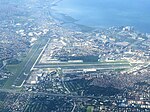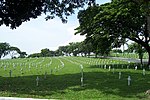Metro Manila Skyway

The Metro Manila Skyway, officially the Metro Manila Skyway System (MMSS) or simply the Skyway, is an elevated highway which is the main expressway in Metro Manila, Philippines. It connects the North and South Luzon Expressways (NLEX and SLEX) with access to Ninoy Aquino International Airport via the NAIA Expressway (NAIAX). It is the first fully grade-separated highway in the Philippines and one of the longest elevated highways in the world, with a total length of approximately 39.2 kilometers (24.4 mi). The expressway runs above major existing highways in Metro Manila and the San Juan River. It passes through the highly urbanized areas of Caloocan, Quezon City, Manila, Makati, Pasay, Taguig, Parañaque, and Muntinlupa, easing congestion on other major thoroughfares. The Skyway is accessible to Class 1 vehicles, such as cars, vans, motorcycles above 400 cc (24 cu in), pick-up trucks, and SUVs, and Class 2 vehicles and public utility vehicles (PUVs). Previously, Class 2 vehicles and PUVs were banned due to the construction of the extension project.
Excerpt from the Wikipedia article Metro Manila Skyway (License: CC BY-SA 3.0, Authors, Images).Metro Manila Skyway
Skyway, Parañaque
Geographical coordinates (GPS) Address Nearby Places Show on map
Geographical coordinates (GPS)
| Latitude | Longitude |
|---|---|
| N 14.506388888889 ° | E 121.03527777778 ° |
Address
Skyway
Skyway
1700 Parañaque
Philippines
Open on Google Maps








